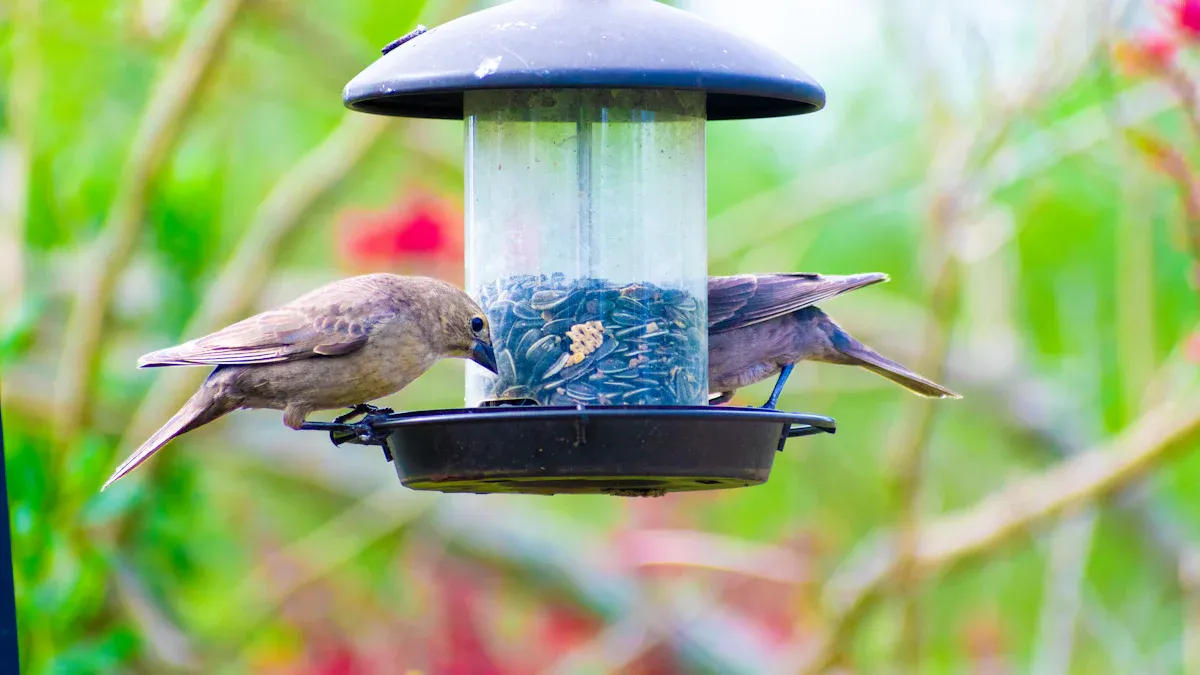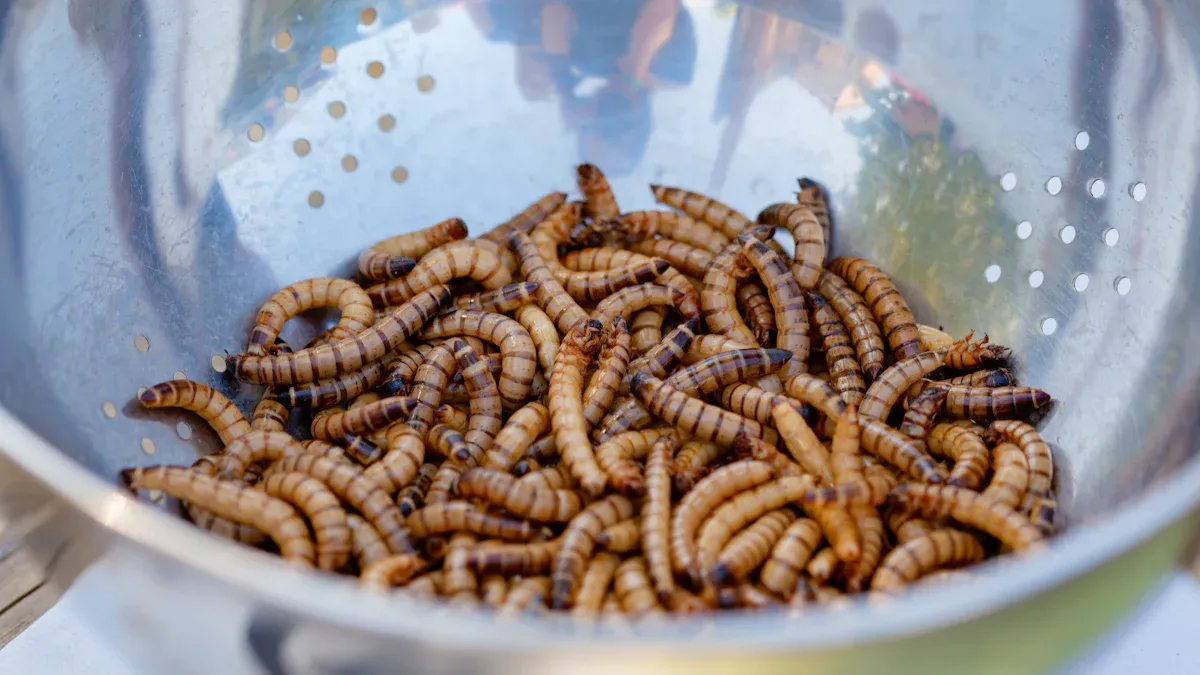
Birds need the right fuel to stay healthy and active, and dried mealworms bird food delivers just that. Packed with essential nutrients, these tiny treats help birds maintain their energy, grow strong feathers, and stay vibrant. Offering mealworms also draws a mix of species to your yard, making birdwatching more exciting.
Key Takeaways
- Dried mealworms are full of protein, giving birds energy to live. Feeding them helps birds grow well and have strong feathers.
- These healthy snacks bring many bird types to your yard. This makes birdwatching more fun. Birds like Bluebirds and Carolina Wrens often visit.
- Giving dried mealworms during tough weather or nesting times helps birds stay healthy. They give important nutrients to keep birds strong and lively.
Nutritional Benefits of Dried Mealworms Bird Food

High Protein Content for Energy and Growth
Protein is a vital nutrient for birds, fueling their energy needs and supporting growth. Dried mealworms bird food stands out as an exceptional source of protein. With a protein content of approximately 50-55%, these tiny treats provide birds with the strength they need to fly, forage, and thrive. In comparison, live mealworms contain only 20% protein, making dried mealworms a far superior choice.
Did you know? Birds rely on protein to build muscle and repair tissues, especially during breeding and nesting seasons. A diet rich in protein ensures their chicks grow strong and healthy.
Here’s a quick look at the nutritional profile of dried mealworms:
| Nutrient | Dried Mealworms |
|---|---|
| Crude Protein | 50% – 55% |
| Crude Fat | 24-25% (min.) |
| Crude Fiber | 6-9% (min.) |
| Moisture | 4-6% |
This high protein content makes dried mealworms bird food an excellent energy booster for birds of all kinds.
Rich in Healthy Fats for Feather Maintenance
Feathers are more than just a bird’s outer covering—they’re essential for flight, insulation, and protection. Healthy fats play a key role in maintaining the quality and strength of feathers. Dried mealworms bird food contains about 24-25% fat, providing birds with the nutrients they need to keep their plumage in top condition.
Birds often molt, shedding old feathers and growing new ones. During this time, they require extra fat in their diet to support the process. The rich fat content in dried mealworms helps birds maintain their vibrant colors and ensures their feathers remain strong and weather-resistant.
Packed with Fiber, Vitamins, and Minerals for Overall Health
A balanced diet is crucial for birds to stay healthy, and dried mealworms bird food delivers just that. Along with protein and fat, these treats are packed with fiber, vitamins, and minerals. Fiber aids digestion, ensuring birds can process their food efficiently. Vitamins and minerals, such as calcium and potassium, support bone health, muscle function, and overall vitality.
Compared to live mealworms, dried mealworms offer higher levels of fiber—6% versus just 2%. This makes them a more beneficial option for birds, especially during times of stress or harsh weather conditions. By including dried mealworms in their diet, bird enthusiasts can help their feathered friends thrive year-round.
Types of Birds That Enjoy Dried Mealworms Bird Food

Common Backyard Birds That Love Mealworms
Backyard birds often flock to feeders offering dried mealworms bird food. These protein-packed treats appeal to a wide variety of species. Carolina Wrens, for instance, eagerly pick at mealworms tossed into brush piles. Bluebirds, known for their striking blue feathers, frequently visit platform feeders during winter when natural food sources are scarce. Even Starlings, with their shimmering plumage, become regular visitors once they discover this tasty snack.
Here’s a quick look at some common backyard birds and their feeding habits:
| Bird Species | Feeding Behavior |
|---|---|
| Wrens | Enjoy dried mealworms and are insect-eating birds. |
| Bluebirds | Regularly visit for mealworms, especially in winter. |
| Mockingbirds | Enjoy dried mealworms as part of their diet. |
| Robins | Will not snub dried mealworms added to their food. |
| Brown Thrashers | Also enjoy dried mealworms in backyard settings. |
Adding dried mealworms to your feeder can turn your yard into a lively hub for these feathered friends.
Seasonal Visitors That Benefit from Mealworms
Some birds only visit during specific seasons, and dried mealworms can be a lifesaver for them. During spring and summer, Warblers and Grosbeaks often stop by, especially when raising their young. These birds need extra protein to fuel their energy-intensive nesting activities. In winter, species like Bluebirds and Robins rely on mealworms to supplement their diet when insects are scarce.
By offering dried mealworms bird food year-round, you can support these seasonal visitors and help them thrive during critical times.
Wild Birds and Their Natural Preference for Mealworms
In the wild, many birds naturally seek out insects like mealworms. Wrens, for example, are avid insect-eaters and will happily devour dried mealworms when offered. Grosbeaks and Warblers also enjoy mealworms, especially when mixed with seeds. These birds instinctively recognize mealworms as a nutritious food source, making them a popular choice for bird enthusiasts.
Providing dried mealworms bird food not only attracts wild birds but also gives them a reliable source of energy and nutrients. It’s a simple way to bring nature closer to home.
How Dried Mealworms Bird Food Helps Birds Thrive
Supporting Birds During Breeding and Nesting Seasons
Breeding and nesting seasons are some of the most demanding times for birds. They need extra energy to build nests, lay eggs, and care for their chicks. Dried mealworms bird food provides the perfect nutritional boost during these critical periods. Packed with protein and healthy fats, mealworms help parent birds stay strong and ensure their chicks grow healthy and robust.
Studies have shown that supplementing birds’ diets with mealworms can significantly improve breeding success. For example, research on reed warblers found that increased prey availability, including mealworms, led to higher first brood productivity. Another study revealed that feeding house sparrows and great tits with mealworms improved chick survival rates. Here’s a quick look at some key findings:
| Study | Key Findings |
|---|---|
| Understanding spatiotemporal effects of food supplementation on host-parasite interactions | Food supplementation with 50–200 mealworms per day improved fledging success and reduced parasite prevalence. |
| PLOS One | Increased prey availability through mealworm supplementation led to higher first brood productivity in reed warblers. |
| Beyond Birding Basics | Supplementing diets with mealworms increased chick survival in house sparrows and great tits. |
By offering dried mealworms bird food during breeding and nesting seasons, bird enthusiasts can play a vital role in supporting their feathered friends.
Helping Birds Survive Harsh Weather Conditions
Harsh weather conditions, such as freezing winters or scorching summers, can make it difficult for birds to find food. During these times, dried mealworms bird food becomes a lifesaver. Its high protein and fat content provide birds with the energy they need to stay warm in winter or cool in summer.
In cold weather, birds burn more calories to maintain their body temperature. Dried mealworms offer a concentrated source of energy, helping them survive even the chilliest nights. Similarly, during hot summers, birds expend energy searching for water and shade. The nutrients in mealworms help them recover and stay active despite the heat.
Adding dried mealworms to feeders during extreme weather not only helps birds survive but also ensures they remain healthy and vibrant. It’s a simple way to make a big difference in their lives.
Boosting Energy Levels During Migration
Migration is one of the most energy-intensive activities for birds. They travel thousands of miles, often without stopping, to reach their destinations. Dried mealworms bird food provides the perfect fuel for these long journeys. With a nutritional profile rich in protein and fats, mealworms help birds build the energy reserves they need for endurance flights.
Research on migrating European starlings highlights the benefits of mealworms in boosting energy levels. The study analyzed the effects of dried mealworms on energy expenditure during migration. It found that the high protein (45%) and fat (33%) content of mealworms made them an ideal food source for migrating birds. Here’s a summary of the findings:
| Evidence Type | Description |
|---|---|
| Energy Levels | The study analyzes the effects of dried mealworms on the energy levels of migrating birds, specifically European starlings. |
| Statistical Analysis | It includes statistical analyses of energy expenditure during endurance flights. |
| Diet Composition | The study details the composition of diets fed to the birds, including dried mealworms, highlighting their nutritional content (45% protein, 33% fats, etc.). |
By offering dried mealworms bird food during migration seasons, bird enthusiasts can help their feathered friends complete their journeys successfully. It’s a small gesture that makes a big impact.
Tips for Feeding Dried Mealworms Bird Food
Choosing the Right Feeder for Mealworms
Selecting the right feeder makes a big difference when offering dried mealworms bird food. Birds prefer feeders that keep their food safe and accessible. Look for feeders with tall sides to prevent mealworms from spilling out. A roof or baffle protects the food from rain, while drainage holes help avoid mold. Tamper-resistant features also keep squirrels and other critters away.
To make mealworms even more appealing, try moistening them slightly. This trick mimics the texture of live insects, which many birds find irresistible. During winter, feeders with extra protection can ensure birds get the fat and protein they need to stay warm.
Tip: Place feeders in areas where birds feel safe, like near shrubs or trees. This encourages more visits and keeps your feathered friends happy.
Mixing Mealworms with Other Bird Foods
Combining dried mealworms with other bird foods creates a balanced diet. Birds benefit from the high-quality protein in mealworms, which provides essential amino acids. Mixing them with seeds, fruits, or suet ensures birds get a variety of nutrients.
Studies show that mealworms enhance growth and physiological health when included in diets at moderate levels. For example, adding up to 6% mealworms to a bird’s diet improves overall nutrition. However, exceeding this amount can affect food quality, so balance is key.
Note: Experiment with different combinations to see what works best for the birds in your area. A mix of mealworms and sunflower seeds is often a favorite!
Feeding Mealworms in Moderation for Optimal Health
While dried mealworms bird food is nutritious, moderation is important. Birds need a varied diet to stay healthy. Too many mealworms can lead to imbalances, especially if they replace other essential foods.
Wild birds require extra fat during winter and protein when raising chicks or molting. Mealworms are perfect for these times but should complement other foods rather than dominate their diet. Offering small portions ensures birds get the benefits without overindulging.
Tip: Start with a handful of mealworms and adjust based on how quickly birds eat them. This prevents waste and keeps their diet balanced.
Dried mealworms bird food offers a simple way to support bird health and vitality. These nutritious treats attract a variety of species, turning backyards into lively birdwatching spots. Adding mealworms to feeders helps birds thrive in all seasons. It’s a rewarding choice for anyone who loves caring for feathered friends.
FAQ
What is the best way to store dried mealworms?
Keep dried mealworms in an airtight container. Store them in a cool, dry place to maintain freshness and prevent spoilage.
Can dried mealworms attract unwanted pests?
No, dried mealworms don’t attract pests like live insects. Use a covered feeder to keep squirrels or other critters away.
How often should I feed birds dried mealworms?
Offer dried mealworms a few times a week. Adjust the amount based on how quickly birds eat them to avoid waste.


